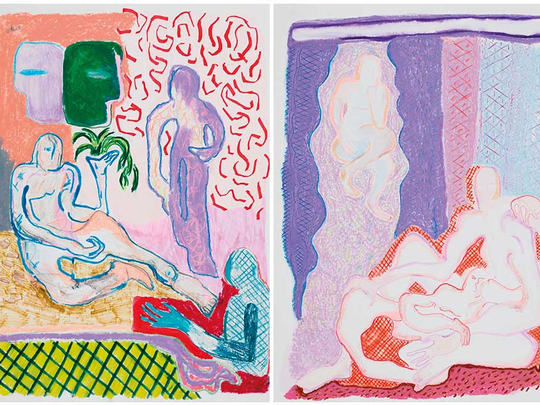
Berlin-based Austrian artist Monika Grabuschnigg’s first solo show in Dubai, What Satisfaction Could You Possibly Have, features large- scale clay reliefs and drawings on paper that explore our changing ideas about love and relationships in a digital world. The artworks reference the omnipresent screens through which we communicate, examining the way we search for and connect with others in a space with infinite choices.
The hazy amorphous intertwined figures in her compositions depict virtual ephemeral encounters freezing intimate moments of fantasy in fleeting relationships. The titles of the show and artworks are borrowed from the writings of famous authors, sociologists and philosophers and offer clues to reading the works.
Grabuschnigg speaks about her work and inspirations.
Excerpts:
How does the title reflect the theme of the show?
This show is about how we form our relationships in contemporary society and focuses especially on disembodied love or cyber love. The phrase What Satisfaction Could You Possibly Have is taken from a modern translation of Shakespeare’s Romeo and Juliet. It is from the scene where the two lovers part for the first time and the crucial moment when they decide to commit themselves to each other before they part.
While working on this subject my main thought was that when you fall in love and commit to someone you must be prepared to fall without a safety net; but this idea of love has changed dramatically now. Today we find ourselves in a consumer market of free choice where we can find countless people who could be a good match for us and it is difficult to decide or make a commitment. I am interested in this subject because the way we interact with each other and form relationships reflects the economic and political environment and social norms of our time.
What do the figures and intimate scenes in the drawings and relief works convey?
These are existential works and the gestures of the figures symbolise human emotions such as waiting, desire and longing. The bodies look like they are being fragmented and rejoined, morphing into one another, or about to disappear alluding to the transient ever-changing nature of cyber relationships and cyber identities. Each image is like a momentary snapshot on our phone screens that tells a story.
It is multi-layered and theatrical, carrying many narratives, and open to different individual interpretations. I think viewers will relate with them and see themselves in the flowing figures.
Where do the intriguing titles of the artworks come from?
I have been immersed in this project for over a year and have done a lot of reading and research on this theme. My reading included the romantic plays of Shakespeare, the writings of sociologist Eva Illouz about love in a consumer market, and the theories of philosophers Roland Barthes and Alain Badiou about love and truth.
I have tried to express their ideas visually, so the titles of my artworks are inspired by their writings. While some are phrases from their books but with a twist, others are my own compositions. After finishing a work, I spend a lot of time thinking about the title because it adds another layer to the narrative and offers a portal for viewers to enter the work.
How do the titles relate to the works and the theme?
For example, the title Smiley people observe peculiar people pledging oneself refers to the fact that today people are watching each other, and everyone knows they are being watched. So they make more rational decisions and nobody wants to take the risk of falling without a safety net. People are trying to find love but there are too many choices.
This is inherently a contradiction because they crave just the opposite. So instead of finding someone they end up losing themselves, becoming disembodied and not knowing where to go. Similarly, the centerpiece of this show, We drink the night with a thirst no lake big enough could ever quench, talks about excess and the idea of never having enough. Other titles such as Gathering in fool’s paradise, Visions in a maze, and The mask of night lingers on my face even when the brightest star sets also relate to cyber relationships.
Were the drawings made as sketches for the reliefs?
No, they are independent artworks. I do not make any sketches for the clay works. I just begin with some shapes and colours in mind and build on that.
I have been working with ceramic for many years, but this is my first experimentation with reliefs. I try to stretch the material to its limits and that is why there are cracks in the sculptures, which are important because this show is about cracks and fractured identities, healing, putting things together and trying again.
Jyoti Kalsi is an arts-enthusiast based in Dubai.
What Satisfaction Could You Possibly Have will run at Carbon 12, Alserkal Avenue, Al Quoz until September 2.












